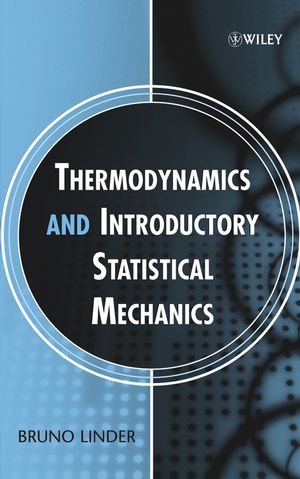Thermodynamics and Introductory Statistical MechanicsISBN: 978-0-471-47459-3
Hardcover
232 pages
September 2004
 This is a Print-on-Demand title. It will be printed specifically to fill your order. Please allow an additional 10-15 days delivery time. The book is not returnable.
|
||||||
1 INTRODUCTORY REMARKS.
1.1 Scope and Objectives.
1.2 Level of Course.
1.3 Course Outline.
1.4 Books.
PART I: THERMODYNAMICS.
2 BASIC CONCEPTS AND DEFINITIONS.
2.1 Systems and Surroundings.
2.2 State Variables and Thermodynamic Properties.
2.3 Intensive and Extensive Variables.
2.4 Homogeneous and Heterogeneous Systems, Phases.
2.5 Work.
2.6 Reversible and Quasi-Static Processes.
2.6.1 Quasi-Static Process.
2.6.2 Reversible Process.
2.7 Adiabatic and Diathermal Walls.
2.8 Thermal Contact and Thermal Equilibrium.
3 THE LAWS OF THERMODYNAMICS I.
3.1 The Zeroth Law—Temperature.
3.2 The First Law—Traditional Approach.
3.3 Mathematical Interlude I: Exact and Inexact Differentials.
3.4 The First Law—Axiomatic Approach.
3.5 Some Applications of the First Law.
3.5.1 Heat Capacity.
3.5.2 Heat and Internal Energy.
3.5.3 Heat and Enthalpy.
3.6 Mathematical Interlude II: Partial Derivatives.
3.6.1 Relations Between Partials of Dependent Variables.
3.6.2 Relations Between Partials with Different Subscripts.
3.7 Other Applications of the First Law.
3.7.1 C<sub>P</sub> — C<sub>V</sub>.
3.7.2 Isothermal Change, Ideal Gas.
3.7.3 Adiabatic Change, Ideal Gas.
3.7.4 The Joule and the Joule-Thomson Coefficients.
4 THE LAWS OF THERMODYNAMICS II.
4.1 The Second Law—Traditional Approach.
4.2 Engine Efficiency: Absolute Temperature.
4.2.1 Ideal Gas.
4.2.2 Coupled Cycles.
4.3 Generalization: Arbitrary Cycle.
4.4 The Clausius Inequality.
4.5 The Second Law—Axiomatic Approach (Carathe´odory).
4.6 Mathematical Interlude III: Pfaffian Differential Forms.
4.7 Pfaffian Expressions in Two Variables.
4.8 Pfaffian Expressions in More Than Two Dimensions.
4.9 Carathe´odory’s Theorem.
4.10 Entropy—Axiomatic Approach.
4.11 Entropy Changes for Nonisolated Systems.
4.12 Summary.
4.13 Some Applications of the Second Law.
4.13.1 Reversible Processes (PV Work Only).
4.13.2 Irreversible Processes.
5 USEFUL FUNCTIONS: THE FREE ENERGY FUNCTIONS.
5.1 Mathematical Interlude IV: Legendre Transformations.
5.1.1 Application of the Legendre Transformation.
5.2 Maxwell Relations.
5.3 The Gibbs-Helmholtz Equations.
5.4 Relation of ΔA and ΔG to Work: Criteria for Spontaneity.
5.4.1 Expansion and Other Types of Work.
5.4.2 Comments.
5.5 Generalization to Open Systems and Systems of Variable Composition.
5.5.1 Single Component System.
5.5.2 Multicomponent Systems.
5.6 The Chemical Potential.
5.7 Mathematical Interlude V: Euler’s Theorem.
5.8 Thermodynamic Potentials.
6 THE THIRD LAW OF THERMODYNAMICS.
6.1 Statements of the Third Law.
6.2 Additional Comments and Conclusions.
7 GENERAL CONDITIONS FOR EQUILIBRIUM AND STABILITY.
7.1 Virtual Variations.
7.2 Thermodynamic Potentials—Inequalities.
7.3 Equilibrium Condition From Energy.
7.3.1 Boundary Fully Heat Conducting, Deformable, Permeable (Normal System).
7.3.2 Special Cases: Boundary Semi-Heat Conducting, Semi-Deformable, or Semi-Permeable.
7.4 Equilibrium Conditions From Other Potentials.
7.5 General Conditions for Stability.
7.6 Stability Conditions From E.
7.7 Stability Conditions From Cross Terms.
7.8 Stability Conditions From Other Potentials.
7.9 Derivatives of Thermodynamic Potentials With Respect to Intensive Variables.
8 APPLICATION OF THERMODYNAMICS TO GASES, LIQUIDS, AND SOLIDS.
8.1 Gases.
8.2 Enthalpy, Entropy, Chemical Potential, Fugacity.
8.2.1 Enthalpy.
8.2.2 Entropy.
8.2.3 Chemical Potential.
8.2.4 Fugacity.
8.3 Standard States of Gases.
8.4 Mixtures of Gases.
8.4.1 Partial Fugacity.
8.4.2 Free Energy, Entropy, Enthalpy, and Volume of Mixing of Gases.
8.5 Thermodynamics of Condensed Systems.
8.5.1 The Chemical Potential.
8.5.2 Entropy.
8.5.3 Enthalpy.
9 PHASE AND CHEMICAL EQUILIBRIA.
9.1 The Phase Rule.
9.2 The Clapeyron Equation.
9.3 The Clausius-Clapeyron Equation.
9.4 The Generalized Clapeyron Equation.
9.5 Chemical Equilibrium.
9.6 The Equilibrium Constant.
10 SOLUTIONS—NONELECTROLYTES.
10.1 Activities and Standard State Conventions.
10.1.1 Gases.
10.1.2 Pure Liquids and Solids.
10.1.3 Mixtures.
10.1.3.1 Liquid–Liquid Solutions—Convention I (Con I).
10.1.3.2 Solid–Liquid Solutions—Convention II (Con II).
10.2 Ideal and Ideally Dilute Solutions; Raoult’s and Henry’s Laws.
10.2.1 Ideal Solutions.
10.2.2 Ideally Dilute Solutions.
10.3 Thermodynamic Functions of Mixing.
10.3.1 For Ideal Solutions.
10.3.2 For Nonideal Solutions.
10.4 Colligative Properties.
10.4.1 Lowering of Solvent Vapor Pressure.
10.4.2 Freezing Point Depression.
10.4.3 Boiling Point Elevation.
10.4.4 Osmotic Pressure.
11 PROCESSES INVOLVING WORK OTHER THAN PRESSURE-VOLUME WORK.
11.1 P-V Work and One Other Type of Work.
11.2 P-V, σA, and fL Work.
12 PHASE TRANSITIONS AND CRITICAL PHENOMENA.
12.1 Stable, Metastable, and Unstable Isotherms.
12.2 The Critical Region.
PART II: INTRODUCTORY STATISTICAL MECHANICS.
13 PRINCIPLES OF STATISTICAL MECHANICS.
13.1 Introduction.
13.2 Preliminary Discussion—Simple Problem.
13.3 Time and Ensemble Averages.
13.4 Number of Microstates, Ω<sub>D</sub>, Distributions D<sub><I>I</I></sub>.
13.5 Mathematical Interlude VI: Combinatory Analysis.
13.6 Fundamental Problem in Statistical Mechanics.
13.7 Maxwell-Boltzmann, Fermi-Dirac, Bose-Einstein Statistics ‘‘Corrected’’ Maxwell-Boltzmann Statistics.
13.7.1 Maxwell-Boltzmann Statistics.
13.7.2 Fermi-Dirac Statistics.
13.7.3 Bose-Einstein Statistics
13.7.4 ‘‘Corrected’’ Maxwell-Boltzmann Statistics.
13.8 Systems of Distinguishable (Localized) and Indistinguishable (Nonlocalized) Particles.
13.9 Maximizing Ω<sub>D</sub>
13.10 Probability of a Quantum State: The Partition Function.
13.10.1 Maxwell-Boltzmann Statistics.
13.10.2 Corrected Maxwell-Boltzmann Statistics.
14 THERMODYNAMIC CONNECTION.
14.1 Energy, Heat, and Work.
14.2 Entropy.
14.2.1 Entropy of Nonlocalized Systems (Gases).
14.2.2 Entropy of Localized Systems (Crystalline Solids).
14.3 Identification of β with 1/kT.
14.4 Pressure.
14.5 The Functions E, H, S, A, G, and μ.
15 MOLECULAR PARTITION FUNCTION.
15.1 Translational Partition Function.
15.2 Vibrational Partition Function: Diatomics.
15.3 Rotational Partition Function: Diatomics.
15.4 Electronic Partition Function.
15.5 Nuclear Spin States.
15.6 The ‘‘Zero’’ of Energy.
16 STATISTICAL MECHANICAL APPLICATIONS.
16.1 Population Ratios.
16.2 Thermodynamic Functions of Gases.
16.3 Equilibrium Constants.
16.4 Systems of Localized Particles: The Einstein Solid.
16.4.1 Energy.
16.4.2 Heat Capacity.
16.4.3 Entropy.
16.5 Summary.
ANNOTATED BIBLIOGRAPHY.
APPENDIX I: HOMEWORK PROBLEM SETS.
Problem Set I.
Problem Set II.
Problem Set III.
Problem Set IV.
Problem Set V.
Problem Set VI.
Problem Set VII.
Problem Set VIII.
Problem Set IX.
Problem Set X.
APPENDIX II: SOLUTIONS TO PROBLEMS.
Solution to Set I.
Solution to Set II.
Solution to Set III.
Solution to Set IV.
Solution to Set V.
Solution to Set VI.
Solution to Set VII.
Solution to Set VIII.
Solution to Set IX.
Solution to Set X.
INDEX.



